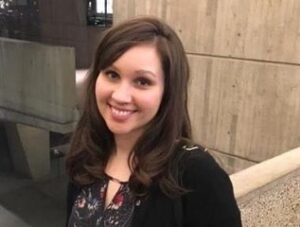
The Metropolitan Museum of Art is the largest art museum in the United States, presenting over 5,000 years of art from around the world, but pieces from the collection don’t always stay on site. Sometimes art is loaned for special exhibitions, and when it is, it is in the good hands of CVPA alumna Catherine Burns (’08 BA German, ’10 BA Art History).
Burns is a Collections Specialist in the Modern and Contemporary Department at the Met, primarily responsible for coordinating acquisitions, which means she oversees the process of cataloging the work and working with the curators and conservators. She also accompanies the art when it leaves the museum:
“One perk of working in collections management is that you often get to travel with the art when it goes on loan to other institutions. I am there to make sure the art is being cared for properly throughout its journey to the borrowing museum. That can sometimes include hours of standing in a cargo warehouse watching a work be packed and loaded. Once you arrive at the borrowing museum, you’re there to make sure the work is installed safely and following the Met’s requirements related to lighting, temperature, humidity, and security.”
In her position, Burns has traveled to many countries, including Australia, France, Mexico, and Switzerland. She says having art as your traveling companion may not be as easy as it might sound:
“My first ever international courier trip was to Basel, Switzerland, and I was traveling with a painting that was too large to fit in the cargo area of a commercial airplane. I was pretty nervous about flying on a cargo plane, but it helped that the pilots were very friendly! They showed me around the plane and even invited me to sit in the cockpit during take off and landing. I got to use headphones to listen to the air traffic controllers. As we were landing in Belgium, the pilots pointed out different cities as we flew over. Seeing the landing from the front of the plane was an incredible experience and witnessing how comfortable the pilots were the whole time has actually made me less of a nervous flyer! The next part of the trip was less glamorous as we had to get the art, and ourselves, to Switzerland from Belgium but, a 12-hour truck ride later, the art was safely in the hands of the borrowing museum.”
Catherine Burns’s path to the Met Museum is just as interesting as some of her art trips.
She started her education in a German immersion elementary school, and when it came time for college, she decided to pursue a foreign language degree at UNC Greensboro. Looking for an elective, she selected what she thought was a studio art class but wound up in “Introduction to Art History” with Associate Professor Heather Holian. Just one semester and she was all in, adding Art History as a minor. After graduation, Burns received a Fulbright Fellowship to teach English at a school in northern Germany for a year. During that time abroad, she discovered what she really wanted to do, and she went back to UNC Greensboro to make it happen:
“While in Europe I visited so many incredible museums and it made me realize I wanted to work in one. When I returned from my year in Germany, I went back to UNCG to complete a bachelor’s degree in Art History. I did an internship at the Bechtler Museum of Modern Art in Charlotte. At the Bechtler, I did a little bit of everything, curatorial work, education, visitor services but what really interested me was collections management. Before my internship I didn’t know what collections management was, but the more I learned about it, the more I realized it was a perfect fit for me. These days I describe it as kind of like being a librarian of a museum collection.”
Burns also completed a Master’s Certificate in Museum Collections Management and Care from the George Washington University, and she did an internship at the Guggenheim Museum in New York before landing her job at the Met.
She says UNCG’s Art History program helped her develop so many of the skills that she uses in her job today:
I loved that the Art History program required me to take a number of studio classes. My painting class with Professor Mariam Stephan is particularly memorable. Working in museums, it has proven to be so useful to have that background and to understand more about an artist‘s process, from stretching and priming a canvas to working with different tools to apply paint. It was in Associate Professor Elizabeth Perrill’s class Salon to Biennale where I started to have more of an understanding of what exactly interested me about museum work. I also loved having access to the Weatherspoon Art Museum. It was a treat to such a great museum on campus.”
Burns’s advice for students is to really explore all of the possibilities that their degree offers:
“When I decided to study Art History/Museum Studies, I thought I would be a curator because I wasn’t really aware of all the other roles within a museum. Now I know there are many careers in museums. There are registrars who are responsible for coordinating shipping and insurance. Exhibition managers are the people coordinating all aspects of exhibitions and managing those budgets. There are also archivists, lawyers, designers, educators, fundraisers, and so many more roles within museums. There’s a whole world of behind-the-scenes people like me!”